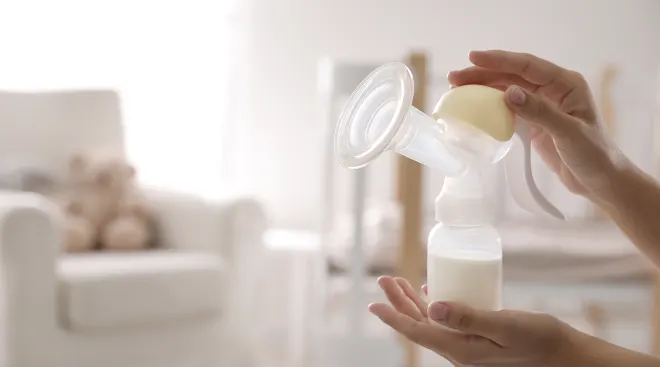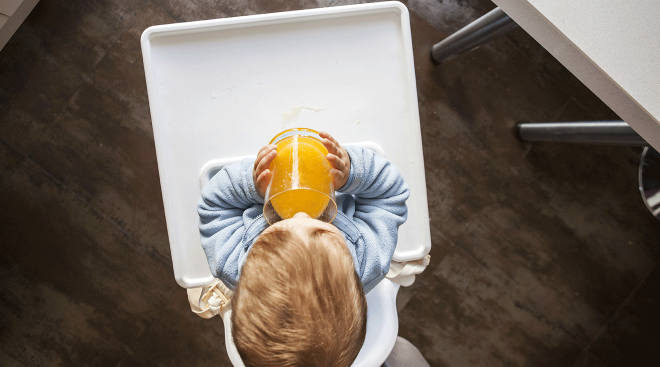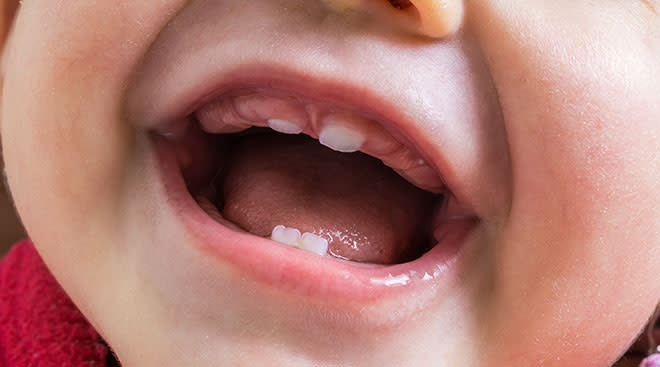Baby Formula Basics: How to Choose the Right One for Baby
If you’ve decided to formula feed baby, you’re hardly alone: While the American Academy of Pediatrics (AAP) still says breast is best (exclusively for at least the first six months), nearly half of American babies are formula fed, and some 42 percent of breastfed babies are supplemented with formula.
There are plenty of reasons why parents need or choose to use formula, which experts say is a perfectly healthy alternative to breast milk. “Your baby will grow up just fine,” says Rallie McAllister, MD, MPH, a family physician in Lexington, Kentucky, and coauthor of The Mommy MD Guide to Your Baby’s First Year. “As a mom, you do what you have to. Remember: Happy mom equals happy baby.” Read on to learn how to choose the best formula for you and baby.
Types of Baby Formula
What is baby formula made of? That depends on the kind of formula you choose. Here are five of the most common types of formula on the market and the ingredients that distinguish them:
Milk-based
Cow’s milk-based formula accounts for nearly 80 percent of baby formula sold in the United States, according to the USDA Economic Research Service. The milk in this formula has been adapted to resemble breast milk—it’s heated and treated to make the protein easy to digest, and the fat is replaced with vegetable oils that are better for infant growth. Milk-based formulas are also fortified with iron to help ward off anemia.
Pros: Of all the types of formula available, it’s the most similar to human breast milk in terms of nutrition, McAllister says.
Cons: Two to three percent of babies wind up developing a cow’s milk protein allergy, according to McAllister. “Keep in mind that this problem may not show up in a baby’s first week—it could present at three weeks” or even later, says Dyan Hes, MD, medical director at Gramercy Pediatrics in New York City. If baby develops an allergy to milk-based formula, she may need to try one of the kinds of formula listed below.
Organic
This milk-based baby formula is certified organic, meaning the cows providing the milk aren’t given antibiotics, feed laced with pesticides or growth hormones to boost their milk production.
Pros: It limits the amount of potentially harmful substances baby ingests.
Cons: You’ll pay more for organic, and it might not be any better than the regular stuff. “Nothing proves that organic formula helps babies be healthier,” Hes says. “But if it gives you peace of mind, that’s fine.”
Soy-based
This formula contains protein from soy as well as carbohydrates that are derived from corn or sucrose instead of lactose.
Pros: It’s a good option for babies who have a cow’s milk allergy or can’t digest lactose or for families that prefer formula that’s not animal-based.
Cons: Soy contains plant estrogens, which can act like the estrogen hormone found in our bodies. There’s some concern that high doses of soy could affect a child’s reproductive organs and maturation, since infants are more vulnerable than adults to its estrogen-like effects. But there haven’t been any specific health problems documented with soy-formula-fed babies, the National Institutes of Health says, and it rates the level of concern as “minimal.” The American Academy of Pediatrics (AAP) considers soy formula to be a safe alternative to cow’s milk formula but recommends giving it to babies only when special circumstances call for it—like if baby is lactose-intolerant or has congenital galactosemia (a rare metabolic disorder) or an allergy to cow’s milk protein, or if your family follows a vegetarian diet.
Enhanced
In 2001 manufacturers debuted baby formula enriched with docosahexaenoic acid (DHA) and arachidonic acid (ARA), which are omega-3 fatty acids naturally found in breast milk and foods such as fish and eggs. You’ll also find formulas enhanced with prebiotics and probiotics that support the growth of healthy bacteria in baby’s gut.
Pros: Studies suggest that omega-3 fatty acids can help bolster baby’s vision and critical thinking skills, and prebiotics and probiotics may give baby more of the immunity benefits of breast milk.
Cons: More studies are needed to determine how significant these benefits actually are.
Specialized
Pediatricians give specialized formulas to babies with health conditions that require it—babies who are born prematurely, have certain disorders and diseases or are allergic to both cow’s milk and soy milk formulas. These specialized formulas can be quite different from standard formulas, so be sure to follow your doctor’s feeding instructions.
Pros: After all the stress of trying to find something that baby can comfortably digest, a specialized formula can give parents some much-needed peace of mind.
Cons: Since it’s specially formulated for babies who can’t handle other types of milk, it’s no great surprise that it comes at a higher cost than standard formula. Plus, specialized formula has to be prescribed by a doctor, which means you can’t just add it to your cart as you shop for groceries.
Types of Baby Formula Preparation
Baby formula comes in three main forms—but when it comes to choosing, the best form is the one that suits your lifestyle, budget and personal preference. Here’s how they differ:
Powder
Powdered formula usually comes in a can with a measuring scoop or in premeasured, travel-friendly packets. Either way, you’ll need to mix the powder with water (bottled, filtered or safe tap water) and shake to blend. You can prepare the formula as you go (and only in the amounts you need), or make a day’s worth in the morning and keep it refrigerated. Follow the package directions to mix the correct proportion of powder to water (it’s usually one scoop of powder for every two ounces of water). “Make small bottles, especially if you have a newborn,” McAllister says. “If your baby is eating an ounce or two at a time, you don’t want to make eight-ounce bottles—you’ll end up throwing too much out.” Powdered formula is the most economical of the three options.
Liquid Concentrate
This is one of the easiest forms of formula to prepare: Just add water to concentrated formula, and shake. With both liquid concentrate and powder, it’s important to make sure the water you add is safe, whether it’s bottled, sterilized or from a trusted tap. Liquid concentrate is generally neater, faster and more convenient than messing with powder, so expect to pay more for the privilege.
Ready-to-Feed
With ready-to-feed formula, there’s no measuring or mixing, no lugging a water bottle around or messing up the ratios: Just pop the top and it’s ready to go! But you’ll pay a price for the convenience. “The problem with ready-to-feed baby formula is that you can only refrigerate it for the length of time specified on the packaging,” Hes says. “It’s also more expensive and heavier to carry.” Tip: It may not be the best choice for travel, since you can’t take 50 gallons of formula on an airplane.
Name-Brand Formula vs. Store-Brand
Of course you want only the best for baby, so you may think it’s a no-brainer to buy formula from a well-known brand, such as Enfamil, Similac, PediaSure, Gerber and Nestlé. But keep in mind that every formula sold in the US, including store-brand formula, is required by the Food and Drug Administration (FDA) to meet the same strict safety, nutrition and manufacturing criteria. “You can feed your baby a generic baby formula, and it’s perfectly okay,” McAllister says. One tip: Don’t switch brands after you’ve found one that works. “Each product could be sourcing their vegetable fat from different places, which may give the formula a slightly different taste,” she says.
How to Prepare Baby Formula
For new moms, preparing formula might seem confusing and even intimidating at first. Not to worry—we asked Hes to answer your top questions (and rounded up some time-saving tips):
Should I warm baby formula?
Yes, warm baby formula to room temperature—but be mindful of how you go about it. “Never warm formula on the stove or in the microwave, since it can heat unevenly—it gets hot in the center and stays cool on top,” Hes says. “Instead, always warm a bottle in a bottle warmer or run it under a warm tap.” Always test the temperature first by shaking a drop onto the inside of your wrist. If it stings, it’s too hot.
Can I make my own baby formula?
Though there are plenty of recipes available online, homemade baby formula is not recommended. “Often times the concentration is incorrect and the levels of salt and sugar are wrong, which can be dangerous for your baby,” she says.
Can I mix formula with breast milk?
Yes. You might mix two ounces of formula with two ounces of breast milk, for example. “It might end up being a lumpy combination, but if your baby likes it, it’s fine,” Hes says. It may help baby transition from breast milk to formula.
Can I mix formula with other ingredients, like cereal?
No. “We don’t recommend putting cereal in a bottle unless your doctor advises it for medical reasons,” Hes says. “We might recommend mixing formula with rice cereal for babies with reflux, for example, but that would be done only if advised by your physician.”
How Much Formula Baby Needs
Most new parents wonder: How much formula does my baby need to thrive? The answer depends on baby’s age. “For the first week, babies will drink one to three ounces every two to three hours,” Hes says. “Usually by two to four months, they’re drinking three to four ounces every three hours.” But there’s no hard and fast rule, as some babies will naturally eat more or less. And that’s probably fine—as long as baby is showing a steady weight gain at every checkup.
Once baby starts eating solids (infants can usually be introduced to solids between 4 and 6 months), you’ll want to cut back on formula. “Baby food is usually things like mashed peas or carrots, and milk and vegetables don’t always mix well—the combination will make some kids vomit,” Hes says. Once you’ve introduced solids, “You can start to give sips of water from the bottle when your baby eats. Then when they go down for a nap, give them formula.”
Most babies can transition directly from infant formula to regular cow’s milk at 12 months. If milk seems problematic for baby, talk to your pediatrician about whether a toddler formula—which has added calcium and phosphorus—would be helpful.
How to Store Baby Formula
It’s important to store baby formula safely to make sure baby gets the healthiest meal possible. Here’s what you need to know:
Check the expiration date
Never buy or use baby formula—powdered or liquid—past its expiration date. If you’ve bought in bulk, always check the date on the packaging first before you feed it to baby.
Use the 24-hour rule
It’s okay to prepare a day’s supply and leave it in the fridge for 24 hours, but then toss what’s left over, McAllister says.
Never put the milk back
Avoid re-refrigerating a used bottle, even if it’s still half-full. You wouldn’t feel good about saving milk that’s been sitting out, right? It’s the same concept.
Keep it cool
Always store formula—powdered or liquid—far from hot spots in the kitchen, such as the stove or oven or near a hot water pipe. Both heat and cold can degrade the nutrients in formula, so avoid freezing baby formula as well.
Troubleshooting Baby Formula Problems
Parents worry—that’s what we do. But when it comes to formula feeding, there are two main concerns that doctors encourage parents to look out for and, if necessary, address:
How do I know if my baby is allergic?
Watch for signs of bloody stool, bad eczema or chronic spitting up. This could also signal an intolerance to the formula, rather than an allergy, but call your pediatrician if these symptoms occur.
How can I tell if my baby is eating enough?
Your baby should have at least four wet diapers a day, and a newborn will likely have a bowel movement after every feeding. As they get older, some babies might only have a bowel movement every five days. If you’re diligent about keeping up with your checkups, your pediatrician will be able to determine whether baby is eating enough for healthy growth. Talk to your doctor if you have any concerns about baby’s weight or growth or if you notice any significant changes in feeding or diaper habits.
Please note: The Bump and the materials and information it contains are not intended to, and do not constitute, medical or other health advice or diagnosis and should not be used as such. You should always consult with a qualified physician or health professional about your specific circumstances.
Navigate forward to interact with the calendar and select a date. Press the question mark key to get the keyboard shortcuts for changing dates.




















































